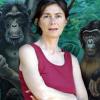Cognition presents evolutionary research with one of its greatest challenges. Cognitive evolution has been explained at the proximate level by shifts in absolute and relative brain volume and at the ultimate level by differences in social and dietary complexity. However, no study has integrated the experimental and phylogenetic approach at the scale required to rigorously test these explanations. Instead, previous research has largely relied on various measures of brain size as proxies for cognitive abilities. We experimentally evaluated these major evolutionary explanations by quantitatively comparing the cognitive performance of 567 individuals representing 36 species on two problem-solving tasks measuring self-control. Phylogenetic analysis revealed that absolute brain volume best predicted performance across species and accounted for considerably more variance than brain volume controlling for body mass. This result corroborates recent advances in evolutionary neurobiology and illustrates the cognitive consequences of cortical reorganization through increases in brain volume. Within primates, dietary breadth but not social group size was a strong predictor of species differences in self-control. Our results implicate robust evolutionary relationships between dietary breadth, absolute brain volume, and self-control. These findings provide a significant first step toward quantifying the primate cognitive phenome and explaining the process of cognitive evolution.
The evolution of self-control
Publication type:
Articolo
Publisher:
The Academy,, Washington, D.C. , Stati Uniti d'America
Source:
Proceedings of the National Academy of Sciences of the United States of America 111 (2014): E2140–E2148. doi:10.1073/pnas.1323533111
info:cnr-pdr/source/autori:MacLean, Evan L.; Hare, Brian; Nunn, Charles L.; Addessi, Elsa; Amici, Federica; Anderson, Rindy C.; Aureli, Filippo; Baker, Joseph M.; Bania, Amanda E.; Barnard, Allison M.; Boogert, Neeltje J.; Brannon, Elizabeth M.; Bray, Emi
Date:
2014
Resource Identifier:
http://www.cnr.it/prodotto/i/310444
https://dx.doi.org/10.1073/pnas.1323533111
info:doi:10.1073/pnas.1323533111
Language:
Eng



